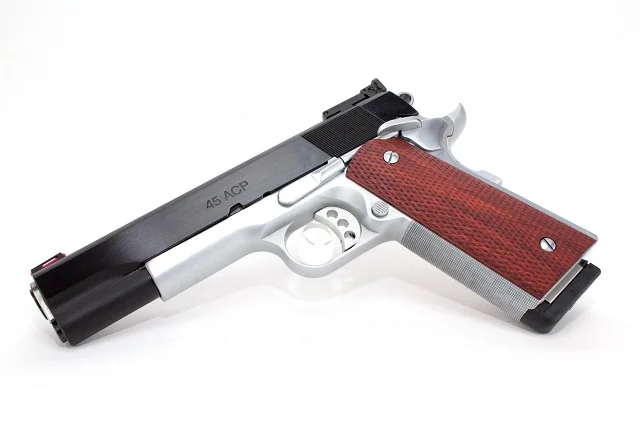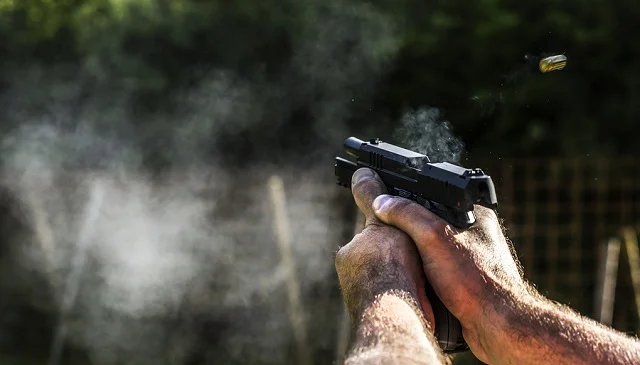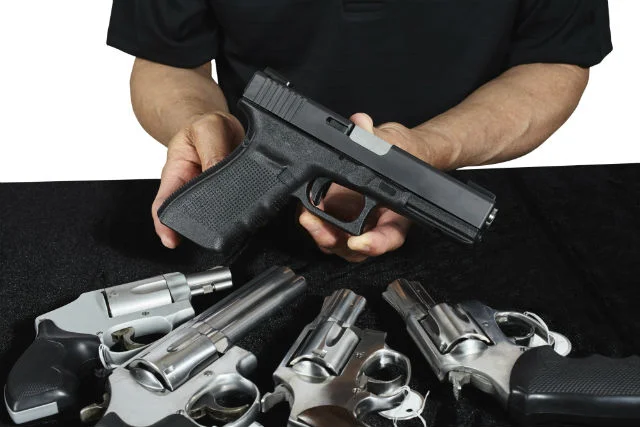
45 Vs 9mm For Defense And Other Purposes
The oldest debate in the handgun book at this point is 9mm vs 45 for concealed carry and/or self-defense. This has been a talking point for decades, partially on historical grounds (which we'll get to) and partially because people just love to have things to argue about.
The truth is that - just like 9mm vs 40 neither round is necessarily any sort of ballistic marvel; both are proven and effective self-defense rounds and you should just shoot whatever you like best and are most accurate with.
With that said, let's dig right in.
45 Vs 9mm: What Sets The Bigger Bullet Apart

There's a reason why some people believe that 45 vs 9mm tilts in favor of the bigger bullet, which stretches back into history. Thing about 45 caliber rounds is they were the best thing going for a while there...back in the days before cars.
The quick version is that until ammunition quality became a major concern, a good insurance policy was to use the biggest, hardest-hitting ammunition one could be reliably accurate and fast with. The .45 caliber rounds like .45 Long Colt, .45 Schofield and - a bit later on - .45 ACP happened to work pretty well in this regard.
The basic version is that if you poke a little hole in someone with a bullet, it might not have much effect. If you poke a bigger hole in them, they may be more apt to cease hostilities. And it worked, so much so that the US armed forces adopted .45 caliber pistols (specifically the 1911 but don't forget the M1917 revolvers) as their standard sidearm starting in 1919 until the mid 1980s.
Today, .45 ACP has all the same virtues it had back in the day. It's a heavy bullet, moving rather slow (less than 900 fps from the muzzle) but carrying a decent amount of kinetic energy so it hits (relatively) hard. A quality hollow point, even at standard pressure loadings, can expand dramatically, up to almost an inch in gelatin or soft tissue. However, recoil is rather tame for a big bullet, and the .45 ACP round is known for great inherent accuracy with decent ammunition
The upshot is that since .45 ACP is an autoloading round, it can be carried more easily than revolvers chambered in .45 Colt, .44 Special, .44 Magnum and certainly .454 Casull. You can even get slim subcompacts like a Shield 45 or Officer 1911 for concealed carry.
.45 ACP is also eligible for Major Power Factor shooting events, and 9mm is not, which has kept .45 alive in competitive shooting.
However, .45 is also fertile ground for handloaders and anyone that's willing to make some modifications to their pistol. Modern .45 ACP is if anything under-loaded, as the case can accommodate almost double the powder charge of standard factory ammunition. When loaded to .45 ACP +P and .45 Super (basically .45 ACP +P+) power levels, magnum velocities and energy levels are easily achievable. However, careful modification of a pistol IS required to accommodate the extra pressure and recoil.
In short, it's a big-bore bullet that's relatively easy to shoot, accurate, and a proven performer in a self-defense capacity.
9mm Vs 45: Rooting For The Little Guy

Why do so many people side with the littler guy in the whole 9mm vs 45 thing? Simple!
The 9mm Parabellum round is just big enough to be effective. It flies fast, flat and is very accurate. Recoil is very tame in a full-size gun, quite reasonable in a compact and more than livable in a subcompact.
When initially released, it was actually something of a hot load. European semi-autos of the day were more commonly chambered for hot .30 caliber pistol rounds such as 7.65mm Borchardt, 7.63mm Mauser and 7.65mm Luger. They flew fast (1,200 fps+) and flat, but Georg Luger wanted to make a round that carried a bit more "oomph," and created the 9x19mm Parabellum.
In that era, revolver rounds of similar size such as .38 Colt and .38 Special were much slower (800 or fewer fps) and were found lacking for punch in combat and on the street. The 9mm round offered some advantage in that regard.
You can also carry a pretty decent supply in a double-stack magazine, if you're okay with carrying a bigger gun. Then again, the Glock 19 isn't that big and carries 15+1, so you don't have to tote an enormous pistol to have a good amount of firepower on hand.
A complaint about 9mm for the longest time was that it lacked for power and ammunition didn't work very well in a defensive capacity. In 1970, that was a fair criticism. By the mid 1990s, not so much. Today, it's mostly bunk. Quality hollow point ammunition is widely available and effective, even for short-barrel pistols such as the type many people conceal and carry on a daily basis.
Big enough to be effective, easy to shoot, accurate and you can carry a pretty decent supply in most pistols. In other words, a Goldilocks bullet.
9mm vs .45 Stopping Power

Talking about 9mm vs .45 stopping power is almost pointless, because handguns don't have any.
Isaac Newton wins again.
Since any action has an equal reaction opposed - Newton's Third Law - the amount of energy going downrange is the same as the amount of energy being directed into the shooter. If you define "stopping power" as enough energy to stop a target in its tracks, the portion of the recoil you feel would have to practically knock you on your posterior.
That is the province of elephant rifles and magnum shotguns, not handguns. Large-bore magnum rifles and magnum shotguns DO produce that kind of kinetic energy, but handguns just don't.
But, since we're here, let's talk about the differences between 9mm vs .45 in terms of terminal ballistics.
So let's start with the kinetic forces. Part and parcel to the wounding potential of any bullet is how much wallop it's bringing with it. Remember, velocity is not as important as you'd think; velocity + energy is far more important.
Common 9mm loads produce somewhere between 350 and 400 ft-lbs of muzzle energy, with 9mm +P loads producing about an extra 50 ft-lbs over standard pressure loads. Contrasting 9mm vs .45 ACP in this regard reveals that .45 ACP has an advantage, but not an astounding one. Granted, that is enough to qualify .45 ACP for Major Power Factor shooting events.
Bear in mind, of course, that typical .45 ACP projectiles are anywhere from 155 grains to 255 grains in weight, with 185-, 200- and 230-grain projectiles being most common. 9mm tops out around 150 grains, with 115-, 124- and 147-grain projectiles being most common. Therefore, it isn't an apples to apples comparison. However, typical .45 ACP loads start at around 350 ft-lbs of energy and - in standard pressure loads - top out just under 500 ft-lbs.
Over-pressure .45 ACP loads (.45 ACP +P and .45 Super) however can push velocities for 230-grain projectiles to or even over 1,000 fps, and 185 projectiles to almost 1,300 fps and close to 700 ft-lbs of energy. This is broadly equal to hot loads of 10mm Auto (and at almost 10,000 fewer pounds per sq inch of chamber pressure) and exceeds .357 Magnum power levels.
But, let us compare a common defense load that you might find on the shelf at your typical gun store.
Consider the differences in Speer Gold Dot, a well-known and well-respected law enforcement and defense load.
9mm 115-grain Gold Dot JHP is billed to make 1,200 fps and 355 ft-lbs from the muzzle. Gold Dot .45 ACP 230-grain JHP is billed for 890 fps and 404 ft-lbs from the muzzle.
Granted, Gold Dot is also available in a 185-grain load in .45 ACP, and 124-grain and 147-grain loads in 9mm. The lighter .45 ACP projectile bumps velocity up to 1050 fps and 435 ft-lbs; the heavier 9mm rounds have slower velocities, at (an alleged) 1150 fps and 985 fps respectively, and muzzle energy of 364 ft-lbs and 326 ft-lbs.
In other words, a little bit of an edge, but not a drastic one. What about expansion inside the target? How big of a permanent wound cavity can either round create?
Expansion within tissue is affected by a great many factors, but at hand is how much bigger can a .45 ACP bullet mushroom out to compared to how big a 9mm round can expand to.
Well, according to Lucky Gunner Labs gel testing, the best-performing 9mm rounds expanded to about 0.7 inches at maximum, and the best-performing .45 ACP rounds expanded to 1 inch at maximum. The average is more like 0.5 inches for 9mm and 0.7 inches for .45 ACP.
What does this mean?
It means that when it comes to 9mm vs .45 stopping power, the advantage that standard-pressure .45 ACP enjoys over 9mm is around 50 to 75 ft lbs more energy, and up to a whopping 0.3 inches (at most) of expansion.
Okay, what does all that blathering on REALLY mean? First, handguns are pipsqueaks in terms of guns. Second, the differences between 9mm vs .45 ACP are marginal at best, so the difference is basically bupkis. In short, it doesn't matter, at least not in the real world.
.45 ACP vs 9mm: What Happens In The Real World?

But what about the track record in the real world of .45 ACP vs 9mm?
We've mentioned it previously, but .45 ACP in military service was noted for being a bit more potent and being a little more effective than 9mm. However, this comes with a bevy of caveats, "yeah buts" and so on that also bear mentioning.
The gist of it is this: 9mm came into prominence with modern ammunition. Prior to that, it didn't have a great track record.
As far as in a military setting, militaries generally use full metal jacket ammunition. .45 ACP is a bigger bullet, meaning it pokes a bigger hole in stuff! The edge in muzzle energy helps it punch through tissue and bone, which is also what makes .45 hardball tenable as a woods cartridge. 9mm hardball has long been rubbished for inefficacy, and there are a number of reports of modern-day soldiers carrying 9mm NATO FMJ that didn't do the job well enough.
But what about in the modern day?
9mm hollow points basically didn't exist on a commercial level until the 1970s, and results were mixed. Some loadings performed well - usually overpressure loadings, such as Corbon and others - and others didn't, and yes that's the reason why some people still think you have to run 9mm +P.
However, .45 ACP hollow points had a bit better track record against fleshy targets, as did 10mm, though .45 ACP was known for being a bit wanting for penetration through barriers. Eventually the .40 S&W emerged as a compromise, and it worked pretty well.
And then modern bonded hollow points emerged, which changed the game. With modern hollow point ammunition, previous deficiencies and objections to 9mm were more or less rendered moot.
Today, not so much. Since the advent of modern bonded hollow points, any advantages of caliber have been more or less abrogated. With use of good ammunition, and if the shooter does their job as a marksman, 9mm or .45 ACP or even .44 Magnum is equally effective.
9mm vs 45: Which Is Better?

Which is better between 9mm vs 45? Well...better for what, exactly? Both are known and proven performers in defensive capacities. Good bullets are available for both, and neither is particularly difficult to shoot.
Go out and shoot both. Did you like one more? Were you a bit more accurate with that one? Good! That's the best one for you.
Much is made about caliber and guns, and the truth is that they are merely tools. What matters far more is the skill of the user. If you can consistently shoot accurately and precisely, that matters for more in every single regard, which rarely depends on caliber.
Ultimately, both are great for personal defense. Neither is necessarily more effective than the other in the real world, so there's nothing to be gained in that regard by either cartridge. It's really all up to you to decide which you'd rather carry.









